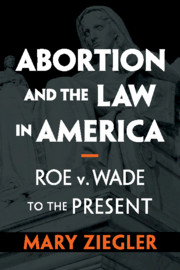Book contents
- Abortion and the Law in America
- Abortion and the Law in America
- Copyright page
- Dedication
- Contents
- Acknowledgments
- Timeline
- Abbreviations
- Introduction
- 1 Roe v. Wade and the Rise of Rights Arguments
- 2 The Hyde Amendment and Its Aftermath
- 3 Launching a Quest to Reverse Roe
- 4 Planned Parenthood v. Casey, the Family, and Equal Citizenship
- 5 Contesting the Relationship between Abortion and Health Care
- 6 Partial-Birth Abortion and Who Decides the Costs and Benefits
- 7 Polarization, Religious Liberty, and the War on Women
- Conclusion
- Notes
- Index
1 - Roe v. Wade and the Rise of Rights Arguments
Published online by Cambridge University Press: 28 February 2020
- Abortion and the Law in America
- Abortion and the Law in America
- Copyright page
- Dedication
- Contents
- Acknowledgments
- Timeline
- Abbreviations
- Introduction
- 1 Roe v. Wade and the Rise of Rights Arguments
- 2 The Hyde Amendment and Its Aftermath
- 3 Launching a Quest to Reverse Roe
- 4 Planned Parenthood v. Casey, the Family, and Equal Citizenship
- 5 Contesting the Relationship between Abortion and Health Care
- 6 Partial-Birth Abortion and Who Decides the Costs and Benefits
- 7 Polarization, Religious Liberty, and the War on Women
- Conclusion
- Notes
- Index
Summary
Chapter 1 provides the background for the story told in the book. In the nineteenth century, when mobilizing to ban abortion, physicians insisted that outlawing the procedure would strengthen the traditional family and improve the nation’s genetic stock by forcing Anglo-Saxon women to have more children. While abortion was illegal for decades, physicians still performed the procedure, justifying it as necessary to save women’s life. But in the 1940s and 1950s, obstetric care improved, making it harder to invoke this justification. Doctors organized to seek the reform of abortion laws, initially arguing that reform would improve women’s health. In the 1960s, however, reformers also argued that legal abortion would prevent the birth of severely disabled children and preserve scarce environmental resources. In the 1960s, as groups formed to defend criminal abortion laws, pro-lifers emphasized arguments about a right to life as a way to expand their movement beyond its existing Catholic membership. As more feminists joined the abortion-rights movement in the late 1960s and early 1970s, grassroots activists demanded the outright repeal of all abortion restrictions, and reformers emphasized rights-based claims of their own. Roe v. Wade made rights-based claims even more important to the discussion.
- Type
- Chapter
- Information
- Abortion and the Law in AmericaRoe v. Wade to the Present, pp. 11 - 26Publisher: Cambridge University PressPrint publication year: 2020
- 1
- Cited by



